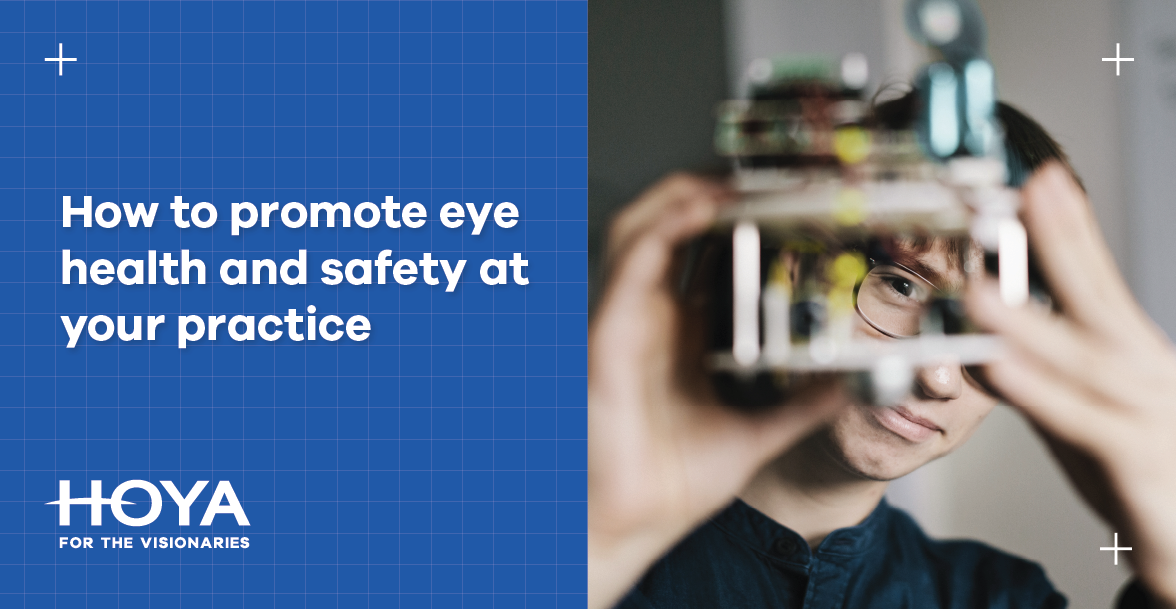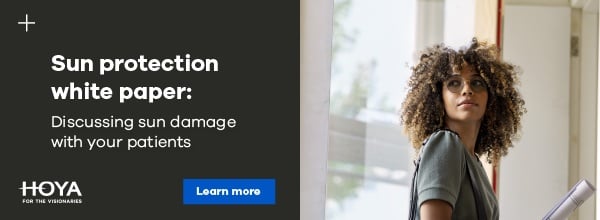March is Workplace Eye Wellness Month – a month centered on the eye health of employees and employers at work. As an ECP, you can put more emphasis on this month at your practice for your own employees and use it as an opportunity to speak to patients about their eye health needs.
To get the conversation going around eye health and safety, start by getting familiar with the most commonly overlooked dangers.
The three most overlooked dangers to eye health in the workplace
For most of us, the first thing we think of when we hear "workplace eye injuries" is something drastic going wrong with a saw on a construction site. While those do happen, the day-to-day wear-and-tear on our visual system from screens, UV rays, and blue light all take their toll in the workplace. Let's look at how we can talk to our patients about these eye safety issues.
1. Digital eye strain

Many of your patients are spending too much time in front of screens as they work remotely or in office. Studies show that on average, adults are spending 11 hours a day viewing screens, and our eyes were not meant for this much blue light exposure.
While you’re visiting with your patients, ask if they are experiencing any of these key symptoms:
- Fluctuation in vision
- Tired eyes
- Headaches
- Light sensitivity
- Eye rubbing and dryness
Patients may be dealing with digital eye strain and need information about blue light exposure and the effects of too much screen time. Our blue light white paper explains everything we already know and don’t know about blue light.
2. UV damage

The National Eye Institute has shown that UV rays can increase the risk of cataracts, and up to 20% of cataracts may be caused by overexposure to UV rays, according to the World Health Organization. Many of your patients could work in the outdoors or in driving occupations. Get curious and ask, “On a typical day, how much time do you spend outdoors or in a vehicle or work?”
Many of your patients could be in landscaping, construction, ride share or delivery services, lifeguarding, trucking or bus driving, or other UV-exposed workplace settings. Asking about their day-to-day will give you the open door you need to discuss the risk of sun damage to the eyes and encourage the use of sunwear.
Sunglasses with 100% UV protection can:
- Help prevent UV-related diseases/eye conditions
- Improve safety from airborne debris, dust, and harsh winds
- Reduce glare, keeping you safe while driving
- Alleviate migraines and headaches
- Improve dark adaptation at night
- Make a better outdoor work experience all year long
3. Solar blue light

Blue light exposure from 15 minutes of sunlight equals the same as 13 hours of screen time.1 Solar blue light, or the electromagnetic radiation that is high-energy visible (HEV), originates from the sun and is absorbed by the retina.
This type of blue light exposure results in poor sleep patterns and can lead to a decreased immune response. Its effects can have long-term impacts as its damage is cumulative and irreversible. HEV light is classified to be 380-500nm.
- Circadian Rhythm impact occurs at 460-480 nm.
- Retinal Effects happen between 420-460 nm — blue light can cause structural and functional damage to ocular tissues.
- Glare and Scatter happen at 380-420 nm — blue light creates extra strain on the eye.
Other than flying debris on major construction sites, UV and blue light damage are your primary sources of eye strain and are linked to age-related macular degeneration (AMD). Quality sunglasses should block 100% of UV and solar blue light when outdoors, which will lower the risk of AMD, cataracts, and cancer of the eyelids and skin around the eyes.
How to reduce exposure to blue light
We talked about 3 under-served eye safety issues. Now, let’s look at specific ways you can help your patients in the workplace:
- Sunglasses
- Photochromic lenses
- Specialty materials
- Specialty coatings
- Giving them eye health advice
Individualized indoor lenses
Your patients could benefit from individualized indoor lenses that are tailored to individual working and wearing conditions.
.png?width=1176&name=hoya-how-to-promote-eye-health-and-safety-blog-lenses%20(1).png)
iD Space: suitable for activities where the focus is slightly further than a computer screen. This lens provides clear vision up close and sharp far vision.
iD Screen: best choice for screen work that requires smooth, sharp depth and width vision from near distances up to 2 meters.
iD Zoom: great for specialist hobbies or professions requiring high precision levels and benefit from the widest possible field of vision at near and intermediate distances up to 1 meter.
Photochromic lenses:
Many people avoid wearing sunglasses because it means carrying two pairs of glasses. That’s why quality lens manufacturers have created light-reactive lens technology – to solve for the “extra pair of glasses” issue. With photochromic lenses, such as our Sensity® family sun lenses, your patients have an option for both blue light protection and light-reactive features in their lenses:
- Sensity® 2: all-day comfort for light-sensitive eyes, no matter the climate, season, or lifestyle
- Sensity® Dark: for outdoor activities and driving – ideal for an active lifestyle
- Sensity® FAST: rapidly changes from dark to clear, for a seamless transition outdoors to indoors
- Sensity® Shine: comfort, convenience, and fashion with a mirror coating on a photochromic lens
Read more: Increase patient satisfaction with light-reactive lenses
Polarized sunglasses:
Polarized lenses actively and directly address the problem of glare and focused reflections.
Key benefits of polarized lenses:
- Safer driving from less glare
- Less eye strain symptoms in bright sunlight
- Great protection (with trivex or a polycarbonate material)
- Reduced glare and better visibility below the surface of the water when out on the lake.
- Less glare and strain when skiing or traveling in the snow.
- 100% UV protection
Premium computer lenses:
Sync IIITM lenses were specifically designed for the single vision wearer who spends more than 2 hours a day on digital devices. These lenses have the distance power for everyday use and a ‘boost zone’ at the bottom of the lens which reduces eye strain during prolonged near activities such as looking at digital screens. This allows your patients’ eye muscles to relax and focus more easily, helping to relieve eye strain and provide visual comfort.
Anti-reflective lens coating
Anti-reflective (AR) coatings have evolved over the years. They started as a way to improve the amount of light passing through the lens to offer the wearer a better visual experience. Today’s premium AR treatments offer an entire lens protection system.
Super HiVision EX3®, for example, provides UV backside protection, scratch resistance, reflection protection, smudge-resistant, and visual clarity.
Benefits of talking about workplace eye health and safety with patients
It’s always a good time to connect with patients about eye health. When you bring up the workplace specifically, you’re able to:
- Find out more about your patient’s daily life
- Build long-lasting rapport with them
- Pinpoint certain scenarios where their eyes may be at risk
- Offer solutions to those workplace eye health problems
- Further educate your staff around workplace eye health
- Enable and encourage staff to engage with customers on this topic
Start the conversation about eye protection
Health-related conversations aren’t always easy, and being a salesman for your practice may not come naturally. That’s why we encourage ECPs to start these conversations with a questionnaire, or ask questions upfront. How often do they use a screen? Do they work inside or outside? Send your patient away with solutions and eye advice for protecting their eye health at work.
Here’s a quick checklist:
- The 20-20-20 rule:every 20 minutes, look at an object 20 feet away for 20 seconds at at time.
- Wear a hat outdoors: a simple solution to protecting all areas of the eyes.
- Adjust your screen intensity: there are browser extensions and other ways to adjust the light intensity of screens.
- Use anti-reflective lenses: reduce the glare and increase contrast while blocking blue light from screens.
HOYA Eye Health Resources for ECPs:
- Retailing sun protection white papers
- Benefits of sunglasses – tips for educating patients
- 10 talking points to start a conversation on Digital Eye Strain symptoms
- Sun Protection White Papers for this Sun Season
- How to sell more sunglasses – tips for opticians
Prevent Blindness resources for ECPs and patients:
- Official Release: Prevent Blindness Workplace Eye Wellness Month
- Eye Safety at Work
- Prevent Blindness Eye Health Infographic Archives
1. Results based on internal testing. Data on file at Vision Ease.






